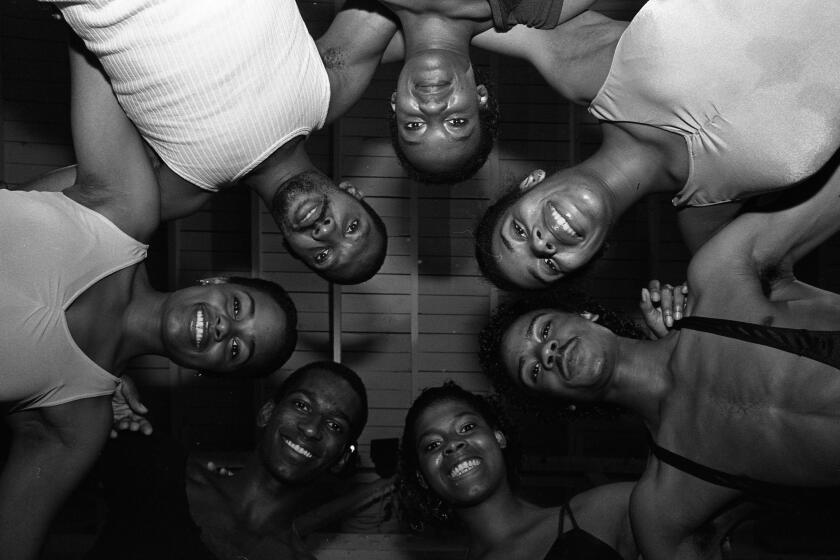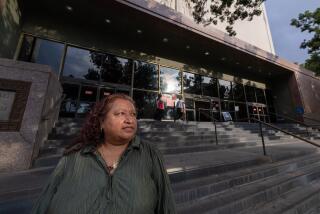Letters to The Times: 1982 series on blacks in Los Angeles
This story originally ran in 1982 as part of the “Black L.A.: Looking at Diversity” series. We have preserved the original text in order to provide an accurate account of the work in print.
Congratulations on your articles on black people in Los Angeles. You are to be commended!
As a middle-aged white person who has spent most of my life in Southern California, the articles were most interesting, and, hopefully, enlightening to people who have not experienced bigotry and prejudice personally.
I graduated from Long Beach Polytechnic High School in 1944 and can remember when a black friend of mine was one of very few blacks in our school. She and I had some rather challenging experiences because of the discrimination against black people by businesses in the area. In fact she and I considered it rather “fun” to go into these business establishments just to irritate them. We were too young to take that bigotry very seriously and we were not “activists” as we know them today.
It seems that circumstances have improved to some degree, at least as you read the differences between the three generations in your article (Aug. 22). However, we still have a very long way to go, and it seems to me that this type of reporting may help to sensitize and educate some people so that some time in the future black people will not have to suffer this way.
— Lila M. Maples
San Clemente
In the summer of 1982, The Times published a series on Southern California’s Black community called “Black L.A.: Looking at Diversity.”
Your article (Aug. 22) on Anna and Henry Laws and their successful efforts against the hateful racial restrictive covenant was of special interest to me. I represented them in the last stages of their fight to live in their own home.
When they came to our office, the injunction forbidding them to live in the house they had built had become final, all appeals from the judgment having been exhausted. They sought advice on whether there were any further steps they could take to resist that injunction and halt the iniquitous practice of enforcing “covenants” against occupants of property by non-whites.
We advised them that, in our opinion, the injunction constituted state action depriving them of equal protection of the laws, was contrary to the 14th Amendment and was also violative of sound public policy. We further advised them that to raise these points, they would have to disobey the injunction, thus inviting a charge of contempt of court for which fine and imprisonment could be levied. Satisfied that this offered an opportunity to continue the fight against racial residential segregation, they chose this course with a quiet determination I found most moving.
In short order, the contempt proceeding was begun. It came to trial before then-Superior Court Judge Allen W. Ashburn, after the first judge to whom it was assigned had disqualified himself by saying in open court that he did not understand why people insisted upon living in places where they were not wanted. At the trial before Judge Ashburn, a great deal of evidence was presented to show that the racial restrictive covenant had resulted in severely limited areas in which blacks were permitted to live and that population pressures in those areas had resulted in overcrowding and unhealthful living conditions for people who were confined in poverty because of discrimination in employment. We also contended that judicial enforcement of the “private agreement” to restrict housing on racial grounds constituted “state action” that could be no better exemplified than by that very proceeding to use the power of the courts to put the Laws in jail for living where the court said they could not merely because of their race.
The taking of evidence was completed at the end of a court day, and argument to the court occurred the following morning. After argument concluded, Judge Ashburn ostentatiously lifted the blotter on his desk, picked up a written opinion that had to have been prepared before he heard argument, and read out his reasons for finding the Laws guilty and sentencing them to jail and to pay a fine they could not pay and to serve additional time.
We secured their release on a write of habeas corpus issued by the California Supreme Court. When I went to the jailhouse to secure their freedom, I was asked to wait by a large holding cell where the prisoners would be brought for final checkout. Henry appeared first. When Anna came in, he greeted her with, “Hello, jailbird.” There was something in their eyes and their voices that bespoke a most affecting intimacy and empathy — as well as a sense of mutual pride and dignity, for they could sense that victory was nearly theirs. It came in a few months. Cases raising the same legal points were before the U.S. Supreme Court and, upon its decision, the California Court rendered its own. The Laws had their house on 92nd Street for their family for good.
The acquisition of that property is itself an interesting study in thrift and perseverance. The Laws bought the vacant lot during the Depression for around $500 on a contract of purchase that required them to pay “Not less than $8 per month.” When they owned the lot free and clear, there were able, with the help of FHA, to get a loan to build the house that the courts up to that time had said they could be kept out of by the “private agreement” of other property owners the Laws had never seen. As to that FHA guarantee of the loan: I don’t suppose the Reaganomics would permit that use of public funds to help a hard-working, purposeful family determined to make for their children a better life than their parents ever knew.
— John T. McTernan
Los Angeles
Anyone interested in the history or the future of human relations should wish to retain a copy of each segment in the series of articles on black Los Angeles!
Charlotte and I started clipping to save them. Such an effort should not be necessary.
The quality and significance of the series is such that it should be published in book form and made available to libraries, schools, book stores and the general public.
It is more than the story of one important segment of the local population. It is an overdue exposition on our society. It is a continuing story in which we are all involved.
— J. Walter Cobb
Eagle Rock
After reading the article on the black family living in Los Angeles since 1910, I was inspired to write you a letter of appreciation.
As a native of Los Angeles, I grew up in the San Fernando Valley with a middle-class family of five. I remember only two black schoolmates all through my school years. We were never exposed to the black person and therefore very naive to the poverty felt in the city.
Los Angeles is always publicized as having a liberal-thinking population where the deep roots of prejudice that originated in the South have never quite touched us. But the fact is they did and are strongly felt but hidden in the subtle way that Los Angeles hides many of its real opinions under a fog of half-truths and psychological manipulations that leave one never really knowing the truth.
It reminds me of a Puerto Rican friend who recently moved to Los Angeles from New York who said the hardest adjustment made in the move came from dealing with the people of Los Angeles. In New York, if someone didn’t like you due to a prejudice, you would know it immediately and directly from the source. But in Los Angeles, there are walls built to camouflage true thoughts and suppress honesty, all in the name of “keeping up the image.”
When you speak to a large portion of the Los Angeles population, you receive the “outer” opinions verbalizing how liberal thinking we are and that “blacks don’t have it any harder than whites.” They have “every opportunity and more than the average white” in our city. Why should we feel sorry for them when we hear of the unemployment rate among blacks, they’re “taking away jobs from whites that can do the job better” anyway.
But the sad truth that much of the L.A. white middle-class population cannot seem to face and does not want to admit is that they are every much as prejudiced as those “bigots” they criticize in the South.
Prejudice has no gray area — it is there or it is not. If felt slightly, if felt strongly, it is still there in all its ugliness. The black person operating under the cloud of subtle prejudice that is outwardly denied in Los Angeles has not had the same opportunity as the white person in our community.
It’s about time Los Angeles woke up to the truth and the publishing of this article on the front page of The Times leaves me feeling glorious joy for the black voice to be heard so loudly.
Bravo Times!
— Debra Booker
Woodland Hills
I’m sick and tired of reading your articles about the poor minorities in Los Angeles. Today’s article (Aug. 23) was the last straw — you made sure that nobody would miss it. I couldn’t read it after reading the introductory paragraph: “The legacy ... of blacks living in Los Angeles is one forged ... in sweat, suffering, compassion, laughter, tears and sometimes blood.”
Oh, the poor blacks. What about the poor white people, those sweating everyday at work only to have a good portion of their paycheck taken for government programs that help all these minorities?
I’m tired of hearing about unfortunate minorities. As far as I’m concerned, the working white people are the unfortunate people.
— Caryn Boyle
Cerritos



